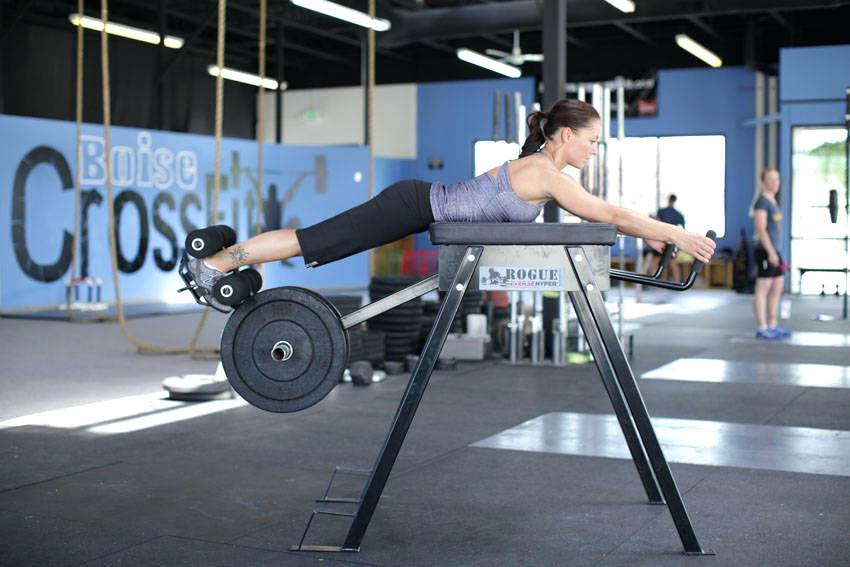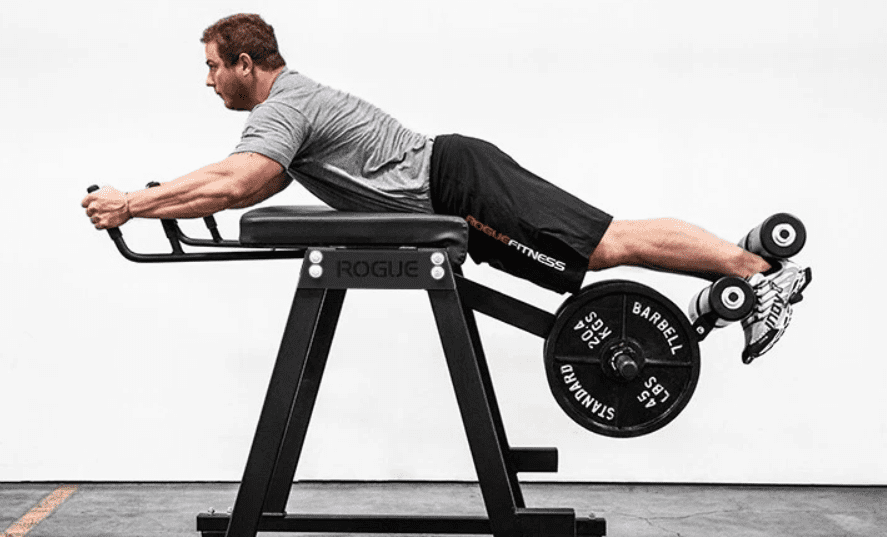Ready to learn about an exercise that renowned powerlifting coach Louie Simmons says will bulletproof your spine? Then you’re in the right place.
Named ‘reverse hypers’ (short for reverse hyperextensions), this exercise can save your back after heavy lifting sessions and strengthen your posterior chain.
The Best Reverse Hyperextension Machines
Simmons invented both the reverse hyper machine and exercise at his gym, Westside Barbell.
It took a bit to catch on, but now you’ll find reverse hyper machines anywhere from a CrossFit gyms to a rec center.
In this guide, we’ll break down what a reverse hyperextension is, it’s benefits, how to program them into your training, and how to do them if you don’t have the equipment.
Oh, and we’ll review the best reverse hyper machines at the end.
What Is A Reverse Hyperextension?

Rogue says the reverse hyper goes ‘beyond rehab’.
Westside Barbell says it’ll save your spine. Big claims—but what exactly does a reverse hyperextension do?
The reverse hyper is a machine (and exercise) that decreases compression on the lower spine. It also strengthens your hamstrings, glutes, and quads.
It’s typically used after a heavy training session (squats and deadlifts especially), or for accessory work.
Here you can see the reverse hyper done with the Rogue machine.
In lieu of the actual machine, two at-home options include using a Bosu ball or sturdy surface like a desk.
Reverse Hyperextension Benefits

Doing reverse hyperextensions can be seriously beneficial for your performance in the gym. The three major benefits are improved leg strength, improved core strength, and for recovery or therapeutic reasons.
Improved Leg Strength
Don’t be surprised when your hamstrings, glutes, and perhaps even lower back are sore after a few sets of reverse hypers.
It’s a good accessory lift for strengthening your posterior chain, which carries over into the deadlift, clean, and snatch.
Improved Core Strength
The reverse hyper is unlike most compound exercises, in that you aren’t using the Valsalva maneuver to brace yourself throughout the exercise.
The Valsalva maneuver is why strength coaches tell you to breathe in on before a squat, and exhale as you come up, as holding your breath helps to stabilize your spine in the bottom of the movement.
However, you use this same bracing technique in the first part of a reverse hyper, which strengthens your core muscles.
Recovery/Therapy Benefits
As the weight swings back, however, you may have to teach your body how to disengage those muscles completely.
It will feel odd at first, because it goes against everything you’re taught about weightlifting.
But disengaging and letting the weight ‘take you’ is where the decompression of your spine and rehab benefits come in.
Heavy barbell lifts put a lot of pressure on the lower back, and reverse hypers help to alleviate some of the tightness that happens after lots of squats or deadlifts.
Related: Best CrossFit Deadlift Workouts to Challenge Your Body and Mind
What Muscles Are Worked Doing A Reverse Hyperextension?
Your hamstrings, glutes, quads, and lower back muscles do most of the work during a reverse hyperextension.
With heavier weights, your hamstrings are forced to contract hard to get the weight going for the first few reps. Done correctly, you’ll be able to use momentum as the set goes on.
How to Program Reverse Hyperextension?

You can add reverse hypers into your programming three to four times per week without any problem.
The key is to start with light weights and work your way up—basically sage advice for any gym exercise.
Start by doing 3 sets of 10-12 reps after your heavy lifts. Rest 1 minute between sets.
Experienced athletes (let’s say anyone that squats 1.5 to 2 times their bodyweight) might start with 25 or 45 lb plates on either side.
Any more than that might feel uncomfortable on your lower back or lead to injury.
If you’re shooting to add posterior chain strength from these, add 5-10 lbs per week.
At-Home Reverse Hyperextension Alternatives

Reverse hyper machines aren’t the cheapest piece of equipment for a home gym.
You may be seeking alternatives to reap the benefits of this exercise.
Two options are using a Bosu ball or sturdy surface like a desk. In either case, you want space for your legs to travel beneath you freely, which may be hard with a Bosu ball.
You can use ankle weights or bands tied to kettlebells to add resistance for either at-home variation.
Top Reverse Hyperextension Machine Reviews
Overall Top Pick
Rogue Z Hyper
- Evolved design from Rogue’s experience
- Adjustable handles for any size person
- Great upgrades from RH-2 model

Pricey? Yes. Heavy? Try 323 pounds. But if you’ve seen a reverse hyper machine at a gym before, chances are it was this Rogue model. This is the newest and evolved version of the reverse hyper machine from Rogue. It is advanced with upgraded features from the standard and original RH-2 reverse hyper machine.
Some upgrades include:
- Adjustable front hold handle bars (2″ to 14″) vs two set handle positions (RH-2). This is a significant upgrade because it allows for any size person to use with proper positioning and comfort. Good upgrade especially for gyms or physical therapist offices.
- Bolts instead of welding(RH-2) design. This may not make a difference to most people who don’t plan on moving it much. But generally this is a better design feature.
- 3″x3″ 11 gauge steel construction vs the 2″x2″ base (RH-2) construction. This upgrade might not be a big deal if its for personal use. However being if you’re purchasing for a gym, this is a good upgrade to handle the wear and tear.
- Base cross member option. This is basically an additional bar at base, on the front side. The purpose is to create additional resistance by adding a resistance band to the weight plate storage post. There are two weight plate storage posts, each 10.5″. Which means you can add 3 each of the 45 lb plates. That’s a total of 270 lbs for both sides. This option is only useful if you need more resistance than that.
Several of the other features like oversized padding, extra overhang of padding so hips are not touching metal, step on the side are all carry overs from the RH-2.
Since there are bolts instead of welding, there is more assembly time with this machine. But it can be done by a single person. Just allocate the time for it. It is a beast, and it is great.
This is a highly recommended machine for lower back pain sufferers, or those just wanting to build up their posterior chain. Make sure to work it in to your leg days.
Lastly regarding value, like they usually do, Rogue delivers on quality. You’ll pay a pretty penny for this model (around $900), but expect it to last you a long time, and it gets results!

Titan is known for making quality equipment at reasonable prices, and that’s exactly the model they followed with their reverse hyper machine.
It costs $300 less than Rogue’s, looks very similar, and reviewers say it assembles easily. This is the more expensive of their two options (economy version is below).
Rogue Fitness RH-2 Reverse Hyper
- Affordable Price
- Two hand hold positions
- 3″ thick padding

This is the original Reverse Hyper from Rogue Fitness. It has several features making it a perfect machine for those looking to decompress their spine without creating vertical compression on it. It helps strengthen the lower lumbar, and athletes can build strength with reduced soreness.
This machine comes ready out of the box. It has a welding instead of bolts (Z Hyper), and weighs 206 lbs. It is made in Columbus, Ohio like most other Rogue Fitness equipment, and likely will be faster delivery than Titan Fitness.
It has a 10.5″ usage storage length for weight plates, so you can fit up to 6 of the 45lb plates.
This machine has all the basic needs and should allow most people to comfortably use it. So if you are looking to save a few bucks (but not that much) compared to the Rogue Z Hyper, then this machine is a solid option.
Conclusion
Reverse hyperextensions took a while to catch on, but nowadays are a very popular tool for rehabbing back injuries and strengthening your posterior chain.
Whether you use it for accessory work or as part of a strength program, you can’t really go wrong with adding them to your programming.
As with any other exercise, start light and progress slowly as the weeks go on.

